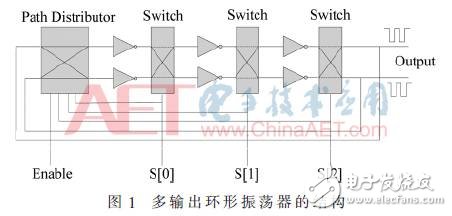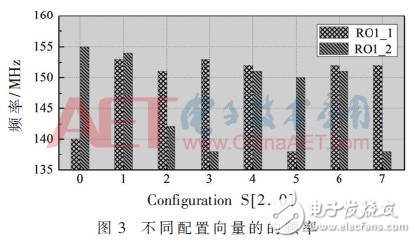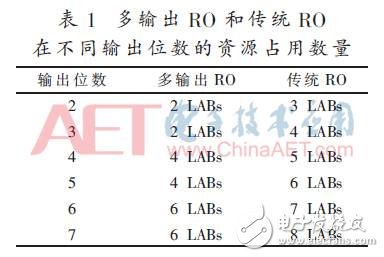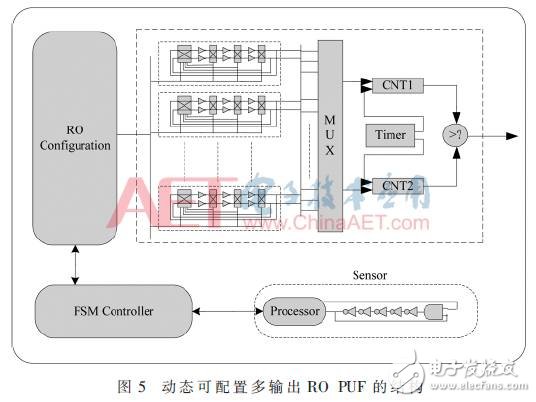Key words: RO PUF; multi-output ring oscillator; dynamic configuration processing module; Hamming distance
CLC number: TP331
Document identification code: A
DOI: 10.16157/j.issn.0258-7998.170750
Chinese citation format: Liu Yongcong, Wang Jianye, Ding Hao. Dynamic configurable multi-output RO PUF [J]. Electronic Technology Application, 2017, 43(9): 43-45, 49.
English Reference Format: Liu Yongcong, Wang Jianye, Ding Hao. Dynamic configurable multi-output RO PUF [J]. Application of Electronic Technique, 2017, 43 (9): 43-45, 49.
0 Preface
With the rapid development and widespread application of computer technology and integrated circuits, chip information security has received more and more attention. The ring oscillator physical unclonable function (RO PUF) is a very promising technology in the field of information security, and has attracted much attention in the field of chip information security [1]. Conventional RO PUF generates an output of 0 or 1 by comparing the frequencies of a pair of ring oscillators placed at different locations on the same chip. Due to random process variations, the output bits will become unpredictable due to different chips [2]. Therefore, a configurable RO PUF based on a conventional RO PUF is proposed. In the configurable RO PUF, the output bits are generated by the configuration vector of the maximum frequency difference [3], which reduces the effects of process variations.
However, both the traditional RO PUF and the configurable RO PUF have one and the same drawback: only one output can be produced by comparing the difference between the two ring oscillator frequencies. In order to generate more output bits, the number of oscillators can only be increased continuously. Although the frequency comparison method can increase the number of output bits, the limited chip resources limit the practical application of the configurable RO PUF [4].
Based on the above deficiencies, this paper proposes a dynamic configurable multi-output RO PUF. Not only does it fundamentally increase the number of output bits, but the number of output bits can be determined based on actual needs. At the same time, the structure of the oscillator changes correspondingly with changes in operating conditions, so that the robustness and security of the chip can be improved.
1 multi-output ring oscillator
The multi-output ring oscillator consists of an inverter, a switching unit and a path distributor, which is the basis of the dynamically configurable multi-output RO PUF. A ring oscillator with multiple output structures is shown in Figure 1.

All of the switching elements in Figure 1 are identical to the switching elements in the arbiter PUF[5]. If the configuration bit in the switch S[0..2] is '1', the signal will cross at the corresponding switch, otherwise the signal will pass in parallel. The oscillator consisting of three switching units in Figure 1 has a total of 8 (23 = 8) signal transmission modes. The path divider is used to ensure that the signal does not cross between the upper and lower paths of the oscillator to ensure stable oscillation of each path. The signal is transmitted from the output of the path divider, through the inverter and switching unit, and finally back to the input pin of the path divider. The path distributor determines the flow of the signal based on the configuration vector of each signal, ensuring that the signal will flow along the previous path when the signal begins to flow again. Different configuration vectors will result in different signal transmission modes. Different transmission modes result in lines and gates with different transmission delays, resulting in different oscillation frequencies.
Compared to the traditional RO PUF, the configurable RO PUF oscillator can only generate one output. The oscillator can only generate one output bit for one LAB. In addition to this, the oscillator can also generate more output bits by adjusting the on/off of the switching unit and the signal distribution path of the path divider.
Figure 2 shows a one-to-multiple output ring oscillator and four output bits (RO1-1, RO1-2, RO2-1, RO2-2). The configuration vectors for RO1 and RO2 are the same. RO1- and RO2-1 have the same path through the logic latches. So the only difference between RO1- and RO2-1 (or RO1-2and RO2-2) is the physical process deviation. Therefore, the RO1-1 and RO2-1 (or RO1-2and RO2-2) frequency comparison results can be used as an output bit.

Experiments were performed in a Xilinx FPGA, as shown in Figure 3. The experimental results show the output frequencies of RO1-1 and RO1-2 under different configuration vectors.

The experimental results show that the output frequencies of RO1-1 and RO1-2 do differ. In addition, their output frequencies vary with the configuration vectors. Therefore, it was verified that the multi-output oscillator structure can effectively generate multiple output bits.
The experimental results of the frequency difference between RO1-1 and RO2-1 and the frequency difference between RO1-2 and RO2-2 under different configuration vectors are shown in Fig. 4. It can be seen that the frequency difference between RO1-1 and RO2-1 and the frequency difference between RO1-2 and RO2-2 are irrelevant. Therefore, their outputs do not affect each other and can be thought of as two independent output bits.

Table 1 lists the chip resource occupancy of multiple output ROs and traditional ROs with different output bits. The second column shows the number of LAB occupations used by one-to-many output ROs to generate different output bits for different output bits. The third column indicates the number of LABs occupied by the traditional RO to produce the corresponding number of output bits. It can be seen that the multi-output RO occupies less chip resources. For example, a 128-bit output requires 65 two-bit output ROs, which can take up to 65 LABs. It can also be generated by 33 four-bit output ROs, accounting for 99 LABs. But if you use a traditional RO structure, you need 129 ROs, accounting for 129. The number of LABs is the largest. It can be seen that multi-output RO has great advantages in chip resource utilization.

2 Dynamic configuration process module
The overall structure of the dynamically configurable multi-output RO PUF is shown in Figure 5. N pairs of two-output paired ring oscillators (ROs) generate 2 (N-1) output bits by comparing the frequencies of adjacent ROs. The sensor consists of a five-stage ring oscillator, and the oscillation frequency is linear with the ambient temperature and the supply voltage [6]. The sensor is mainly used to detect the working condition of the chip. In order to dynamically adjust the structure of the adjacent oscillator according to the environmental conditions, to ensure that the adjacent ROs maintain a relatively large frequency difference, when the ambient temperature and operating voltage exceed a preset threshold, the FSM controller [7] starts. The dynamic configuration process thus calculates the "optimal configuration vector" in the current environment. Therefore, the impact of the environment on the output bits will be reduced, resulting in improved robustness of the dynamically configurable multi-output RO PUF.

The "optimal configuration vector" is not simply a vector that produces the largest frequency difference. Instead, it is determined by the distribution of the frequency difference of the ROs. The positive frequency differences of all ROs under different configuration vectors are summed. If the positive frequency difference of the previous ROs is greater than the positive frequency difference of the next ROs, indicating that the frequency difference between the upper and lower pairs of ROs is positive, the configuration vector that maximizes the positive frequency difference is selected as the "optimal configuration vector". Conversely, if the positive frequency difference of the previous ROs is smaller than the positive frequency difference of the next ROs, a corresponding configuration vector with the largest negative frequency difference is selected as the "optimal configuration vector", thereby expanding the absolute value of the upper and lower frequency differences, thereby improving Comparison accuracy.
3 Experimental results
Data extraction is performed on 10 Xilinx Spartan XC3S1000 FPGAs, and data is transferred to MicroBlaze for processing through a Fast Single Link interface. Each FPGA produces a 128-bit output with 65 ROs. Each output is measured 50 times. Data analysis was performed on the traditional RO PUF, the configurable RO PUF, and the dynamically configurable multi-output RO PUF.
The average inter-picture Hamming distance ratio of the RO PUF [8] can characterize the discrimination between the same type of PUF circuit and other individuals. Its calculation method is as shown in formula (1).

Where hij indicates that the bit outputs generated by the i-th and j-th PUF circuits correspond, and k is the number of FPGAs. The average inter-segment Hamming distance ratio at which different RO PUFs can be obtained after data extraction is as shown in Table 2.

Comparing the above three kinds of RO PUF to the total number of bits output corresponding to the average inter-segment Hamming distance ratio results, it can be seen that the average ROHM of the three kinds of RO PUF is close to the ideal 50%, dynamic configurable multi-output RO PUF has the highest ratio of Hamming distance between films. However, all three RO PUFs showed good uniqueness. Therefore, the outputs of the three RO PUFs can be used as each chip ID.
The on-chip Hamming distance can describe the robustness and reliability of the PUF system, and its calculation is as shown in equation (2).

Among them, M is the number of different working environments, hri is the n-bit output response under ideal working conditions (25 °C, 1.2 V) and the i-th working condition comparison condition. Because robustness and reliability are mainly affected by ambient temperature and supply voltage. Let the Xilinx FPGAs used in the fixed working environment and the changing working environment respectively to extract the parameters and detect the Hamming distance in the chip.
(1) Under fixed ambient temperature and power supply voltage
The parameters were extracted at a temperature of 30 °C and 1.2 V close to the ideal working environment. The average on-chip Hamming distance of different RO PUF structures is shown in Table 3.

Test error and on-chip noise are the main factors affecting the robustness of the FPGA under standard operating conditions [9]. As can be seen from the table, the configurable RO PUF can reduce the RO PUF to almost zero for error and noise.
(2) Under changing ambient temperature and power supply voltage
Under realistic conditions, the working temperature and power supply voltage of the chip are constantly changing. Therefore, reducing the ambient temperature and power supply voltage is significant for the impact of chip ID extraction. Table 4 shows the average on-chip Hamming distance ratio of the three RO PUFs when the ambient temperature changes from -30 °C to +70 °C and the voltage changes from 1.15 V to 1.25 V. Although the dynamic configurable RO PUF does not have a great advantage in ID extraction when the temperature changes, the configurable multi-output RO PUF has the lowest in-place flip rate when the power supply voltage changes, and the chip ID can be extracted more accurately.

4 Conclusion
In this paper, based on the fact that the traditional RO PUF and configurable RO PUF output bits are insufficient and the chip resources are too much, the configurable RO PUF is improved, and the dynamic configurable multi-output RO PUF is proposed. While saving chip resources, it also improves the uniqueness and robustness of the system, thereby improving the accuracy of extracting the chip ID. It is of great significance to apply chip IP intellectual property (IP core) protection to RO PUF.
Crank Connecting Rod Mechanism
Crank And Connecting Rod Mechanism,Connecting Rod Mechanism,Crank Mechanism Con Connecting Rod,Crank Mechanism Part-Connecting Rod
Chongqing LDJM Engine Parts Center , https://www.ckcummins.com